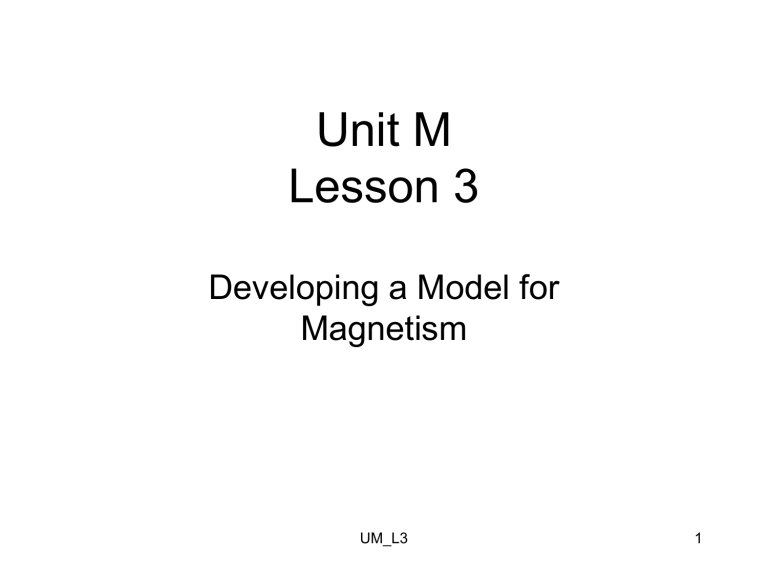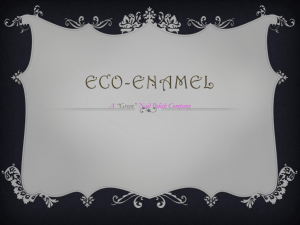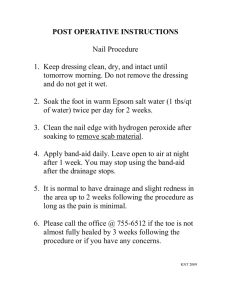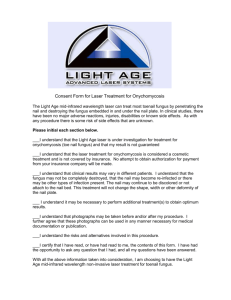PowerPoint Slides for Magnetism Activity

Unit M
Lesson 3
Developing a Model for
Magnetism
UM_L3 1
Lesson 3 Key Question
UM_L3 2
Working in Group
• Monitor : Student whose last name is closest to end of alphabet should monitor group discussion, ensuring that everyone has opportunity to share ideas, and that the group is not off task.
• Reader : Student whose last name is second closest to end of alphabet should read instructions to group when appropriate.
UM_L3 3
Review of UM_L02
• Observations:
– Magnetized nail attracts each end of unmagnetized nail
– Magnetized nail attracts one end of another magnetized nail, and repels the other end
• Conclusion:
– Magnetized nail (object) is two-ended
UM_L3 4
Review of U1L02
• Definition:
– When a magnetized object is allowed to rotate freely, the end that points towards the geographical north is defined as the
North Pole of the magnetized object.
– The other end is the South Pole
• Conclusion from Observations:
– Like Poles Repel, Opposite Poles Attract
– Law of Magnetic Poles
UM_L3 5
Review of UM_L02
• Observation:
– When a magnetized nail is dropped in water, it remains magnetized.
• Conclusion:
– Water does not affect the magnetic properties of a magnetized object.
UM_L3 6
Part 1: What is your initial model of magnetism
• A model is a representation (text, diagrams and/or equations) that can
‘ explain ’ a range of phenomena. You did this in Lesson 1 when you developed a model for the mystery tube.
UM_L3 7
Characteristics of a ‘Good Model’
• It should be clear and understandable
• It should be plausible and causal; that is, it should make sense according to your own ideas about cause and effect (mechanistic); e.g. it should use the Law of Magnetic Poles.
• It should be able to explain (account for) all the observable evidence and not contradict any of that evidence; e.g. explain why a rubbed nail is two-ended.
• It should be able to make valid predictions
UM_L3 8 about what would happen in new experiments.
Part 1: Your own (individual) initial model for magnetism (Room is quiet!)
• Sketch what you think is going on inside or on the surface of the nail. Include some type or types of entities on or in the nail and show what happens to the entities when the nail is rubbed (magnetized).
• Model should ‘explain’ all the observations and conclusions from the previous activity; why rubbing the unmagnetized nail magnetizes it; i.e. makes it two-ended, with a NP at its point end and a SP at its head end. Use
Law of Magnetic Poles.
?
Describe your model in words
?
nail becomes magnetized?
SP
UM_L3 9
NP
Part 1: Your group’s best initial model for magnetism
• Decide on your group’s best model (best able to explain observations and conclusions from UM_L2), sketch and describe it.
SP
Describe your model in words —what happens to the nail when it becomes magnetized?
NP
UM_L3 10
UM_L3 11
Most common initial model in the class is a separation model
• During rubbing the entities (N and S; or + and -) separate to the two halves of the nail because one type is attracted to one of the
Poles of the magnet, and the other type is repelled; one end of the nail becomes the NP and the other end becomes the SP.
• For consistency in comparing models in the class, we should use a common set of symbols to represent the entities inside the nail: Since batteries have + and - symbols and are associated with electricity, and since N and S symbols (Poles) are associated with magnets, let us all agree to use the N and S symbols from now on in our models.
• Even if your group’s model is not a separation model, you should still include the N and S symbols as part of your model.
UM_L3 12
If appropriate, re-draw your group’s initial model using N and S symbols
SP
UM_L3 13
NP
What can the separation model explain?
• Why is a magnetized nail two-ended?
– Each end has either only N’s or only S’s, so that would suggest each end would behave differently.
• Why does an unmagnetized nail produce no magnetic effects?
– In the unmagnetized nail there are random placements of N’s and S’s, so they can cancel out each others’ effects
UM_L3 14
What can the separation model explain?
• Why does a magnetized nail produce magnetic effects?
– One end has only N’s and they can reinforce each others’ effects; the other end has only S’s and they can reinforce each others’ effects.
• Why does touching or washing a magnetized nail not change its magnetization?
– The N and S entities are inside the nail, not on its surface, so touching or washing the surface
15
Part 2: Testing initial model
• But if a model is ‘good,’ then it must also be able to guide predictions for phenomena that have not yet been observed.
UM_L3 16
Part 2: Testing initial model
• On a separate sheet of paper one group member draw your model for the magnetized nail, carefully placing the entities where you think they are. Make it large.
Here is one example. Yours may look different.
Magnetized nail SP
S
S
S
S
S
S
S
S
S
S
N
N
N
N
N
N
N
N
N N
NP
UM_L3 17
Part 2: Testing initial model
Magnetized nail SP
S
S
S
S
S
S
S
S
S
S
N
N
N
N
N
N
N
N
N N
NP
• Draw a thick vertical line through the middle of your model picture for the magnetized nail. Above is an example.
• Tear your picture in half along the vertical line and separate the two halves. [This would be ‘like’ cutting the magnetized nail in half.] Then draw the entities inside each half piece in your student lesson sheet on page 24.
?
?
UM_L3 18
Does your model suggest ….
The head half-piece is two-ended, one-ended*, or something else?
The point half piece is two-ended, one-ended*, or something else?
*One-ended means that the entities are the same on each end, suggesting each end would behave the same.
UM_L3 19
Using your model to make a prediction
UM_L3 20
Testing your model’s prediction: Watch movie and record observations before/after nail is cut on pages 25-26.
UM_L3 21
UM_L3 22
Does the evidence suggest your initial group model needs to be revised in some way?
Magnetized nail
SP
S
S S
S
S
S S
S
S
S
?
N
N
N
N
N
N
N
N
N N
NP
Before trying to modify your model, consider one more piece of evidence…
UM_L3
23
What happens if the magnetized nail is cut into unequal length pieces? Watch movie and record observations on p. 27
UM_L3 24
Your group’s revised model
Revise your group’s model so that it can explain why each piece of the cut nail is still magnetized (two-ended) after the initially magnetized nail is cut anywhere along its length.
• E-mail picture of your group’s revised model, with subject Group # revised model , to your instructor.
UM_L3 25
Summarizing Question
Summarizing Question
UM_L3 26
For Next Period
• UM Extension B (in NextGenPET student resources) and UM Ext B Quiz (in
Assignments section of Bb).
– Evaluating models of magnetism
• Next period we will work through UM_L4
UM_L3 27







